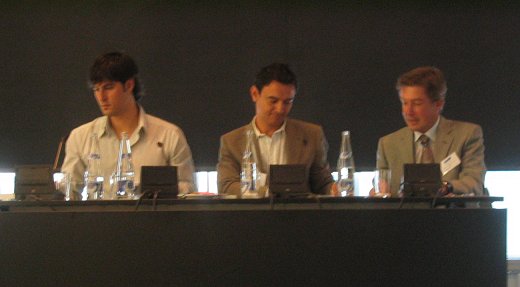1st day of a well organized IQPC conference on Web Site Globalization, Barcelona Sep 20, 2007
Bruno Herrmann – Marketing Manager, Web Content
THE NIELSEN COMPANY
Chairperson’s Welcome Address:
“Web globalization is an important topic and there is room for improvement on many sites.”
Web Site Globalization Conference – Wednesday Morning Session
- usability of flags to indicate languages or currencies (UK/US/Australia problem) – DON’T!
- AVIS.ch: No language except EN (in a multilingual country!)
- HILTI Honkong: Text on images not translated
Maikki Frisk – Senior Manager Operations Development
NOKIA MULTIMEDIA
“Expanding Your Web Presence on Both a Global & Local Scale while Maintaining Brand Consistency”
Globalization aspects of the Nokia music store. Primary goal being global brand consistency (”connecting people”).
OVI (www.ovi.com) is Nokia’s new Internet brand , launched only weeks ago.
- Consists of music store, communities, and games, all for both mobile devices and PCs
- Music store: access from, search, buy, playlists, podcasts…
- iTunes competitor, but with over the air downloading and no proprietary DRM (Windows DRM)
Localization needs:
- local music
- content
- language,
- currency
- payment methods
- campaigns
- look and feel
Nokia has a team to deal with online globalization issues, consisiting of international and global experts. Unified content management and workflows are in place, specified by guidelines. All systems (CMS, templates, workflows) support local requirements. Nokia is not using a translation management system.
Katherine Attoe – Global Communications
IT BUSINESS PARTNERS, UNILEVER
“The One Unilver Project”
Unilever facts:
- 100 company sites + Unilever.com in 74 countries
- brand is about “feel good”
“One Univelver” Project:
In 2004 Unilever started to introduce a more central approach to online publishing, including online strategy. Before 2004 all countries made their own sites. All sites now have consistent design, single technology (Tridion) , global content creation with local translation, localization and/or re-purposing. Local content added in addition. Significant savings after 2004.
One Unilever today:
- 5 days to publish a new site (a new blueprint). 2 day CMS training course.
- common look and feel all sites
- one global search engine and branded content QC through 3rd party (ActiveStandards from Magus)
- shared content, images and tools (polls…)
- aggregated web metrics
- centralized secure hosting
Challenges:
- Senior management buy-in
- Content quality
- Quality assurance
Translation management (TMS) not in use. Local site is created by locally translating a blueprint master
Found to be very important: Developing local business champions, and integration with other channels.
Next steps:
- design and strategy review
- SEO
- more Web 2.0 (doing Podcasts, video and RSS already)
- blogging currently evaluated
Panel discussion
“Evaluating and Translating Your Web Efforts into Financial Terms to Secure Senior Management Buy-In”

Miguel Sánchez- Director SEO
iPROSPECT
Mauricio Garza – Consultant Europe
COMMON SENSE ADVISORY
Fulvio Marfoni – Business Process Architect UnAssisted Support
HEWLETT PACKARD
Q1: Why SEO the localized content?
A: Google evaluates 165 variables per site for the ranking
Local SEO is NOT just translating the English keywords and not just translating the SEO’ed English copy.
Local versions need to have their own domain name with the local top level domain or subdomains like italy.site.com.
Q2: How to get management buy-in for the cost of translation with involving specialists to ensure cultural differences?
A: Only translating English content (without actually localizing it) is not enough. Tone of voice and other local differences to be implemented. Proven on eCommerce sites that real localization generates more revenue. It usually takes years to get management buy-in for proper online content translation management. The Google API can help identify search keywords used in different languages and often shows differences to their “just translated” English counterparts.
Q3: Informatinoal vs. transactional sites. How to convince management to make budget available for purely informational sites?
A: Much harder – if not impossible – to determine translation ROI for informational sites. Refer to widely published figures:
only 30% of all web users speak are native English speakers, will soon be even less
13% speak Chinese
52% intenet users only buy on sites that have their native language
generate your own stats (based on browser language and geolocation stats)
Refer to potential cost savings of translation management. Sony sees click through rates on emails up to 10 times higher on emails with subject and body in local language.
On transactional sites the localized language is very imporant. All research shows significant increase in sales after localization.
Q4: Better to have only a few languages, properly localized, or having many languages not properly localized?
A: To be decided on company needs (main markets, main languages…). At least for focus markets proper language localization needs to be done. Usually multiple English localizations (US, UK, AUS, CAN…) are not justifiable.
Steven Joseph – Web Manager, CMC Global Brand Management
AMADEUS
“Ensuring Business Alignment Through Consensus Building and Regional Input”
Amadeus = Technology for tourism industry (airlines, hotels, booking, content…), present in 217 local markets.
Amadeus sites:
- Amadeus.com (globval audience, sign-post site)
- 10 customer segment sites (content repository for country sites)
- 46 country sites
Prior to 2005 completely decentralized approach. Improvement was needed.
Local marketing/website manager’s dream:
- wants to be left alone
- but paid from central budget
- promises a perfectly targeted site
Result: Brand inconsistency!Central web managers dream:
- give me all the local money and resources and the mandate
- let me implement online brand consistency
- let me provide corporate messages for local roll-out, aligned with the global strategy
Reality: Local teams need to have site ownership, identify themselves with them. Otherwise they will not extend/use and promote the sites!
Amadeus solution to balance central and local needs:
- central strategy with local involvement
- standard templates and clear brand guidelines
- content provided in EN and local companies can choose and translate
- imagery on sites is local choice
- involving local marketers at an early stage
- developing and supporting local eChampions
- local cost savings
- allow for content and language localization
- some central content is mandatory
- central translation of mandatory content into 7 different languages, non-mandatory content and other languages to be translated by local companies themselves with local budget
- allow some individuality (”close your eyes approach”), e.g. Amadeus Columbia uses rounded corners
Main cultural challenges:
- Marketing teams still think print (want web template changes to squeeze their local offline campaigns in)
- Marketer vs. techie discussion (marketers don’t want to handle the CMS). Update web sites using a CMS is a marketing function today!!
- Ofter the CMS workflows requested are either too complicated or too loose. Good experience with only one person responsibe for approval.
- Techno-fear (e.g. creating links in and uploading docs into the CMS)
Main technical challenges (CMS):
- the CMS is often blamed for causing the problems
- local bandwidth issues to access the CMS (and to decide what mandatory multimedia content goes on)
- CMS bugs
Extranet to provide to agencies:
- brand and technical guidelines
- development resources
Competitive spirit helps to improve site quality and promotion. Amadeus publishes stats for all sites to all LoCos regularly.
Next step: provide system to publish best practices and experiences so that all site owners can implement successfully, too.
Excellent talk!
Next: Afternoon session


 The soldierer.com web site is hosted on a
The soldierer.com web site is hosted on a